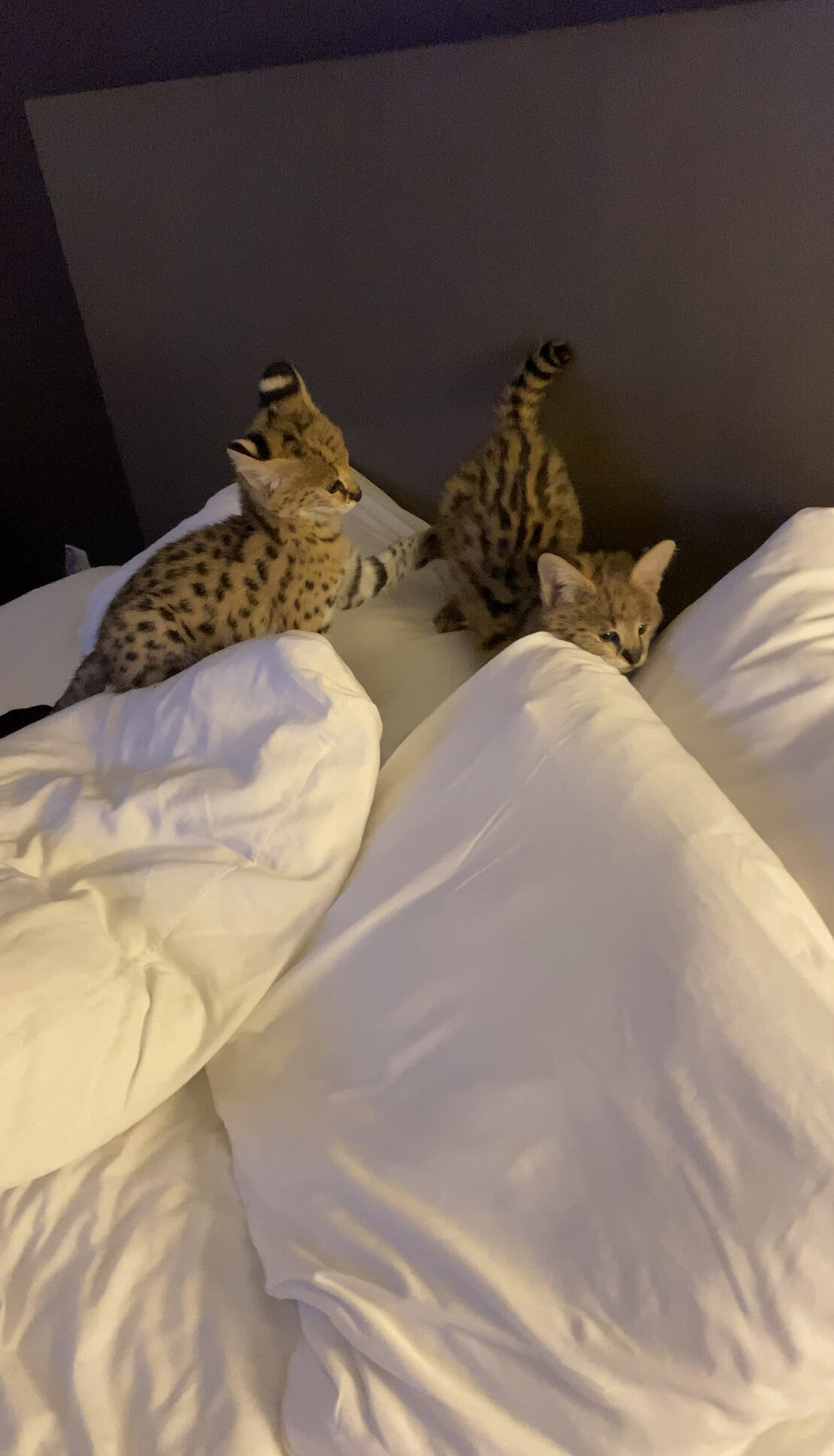serval kittens for sale
Serval kittens can only be placed in homes of legal states or to permitted owners. DO NOT CONTACT US OTHERWISE. Servals are not for the novice pet owner. We offer free consultations to discuss whether or not a serval is right for your home, typically the answer is no. They can make great pets, however they do not tend to like strangers, they can be difficult to get to the vet. They need an outdoor enclosure. You need to know that you will live in your legal state for the next 15 + years. You need to know what you will do to take care of your cat when your out of town. You need A LOT OF FREE TIME for the first 6 months of your kittens life to properly socialize them and bond. YOU NEED PATIENCE! You need to be dominant. You need to be aware of the cat you are getting!
That being said, if you have some knowledge and would like to discuss we are happy to help.
DO NOT BUY A SERVAL PET FROM A ZOO!
A serval must be hand raised and loved on for the first 8 weeks of its life, the kitten must melt in your arms or they will most definetely not be a pet! A CHEAP SERVAL IS NOT A PET SERVAL.
we hand raise our babies in a USDA licensed facility and they are loved on every moment they are awake, socialized with other cats and dogs.
Did you know that African Servals were the very first domesticated cats? They were domesticated before any other domestic cat breed you see today. When I say domesticated I mean kept with a human family and allowed to roam freely in a family home.
Did you know that a cat cannot be fully domesticated? If placed back into the wild, your persian, miss prissy, can still survive on her own. Her instincts to hunt are still there. So because of this she is not fully domesticated. Does this make her a dangerous pet? Apparently this is the excuse a lot of people use when arguing that servals shouldn't be kept as pets.
Servals have been raised as pets for thousands of years and the servals you see today as pets are not taken from the wild but have been bred in captivity by serval breeders throughout the world for hundreds of years.
Please remove from your mind the stereotype that any cat with spots belongs in the wild. Just because servals still have ancestors in the wild doesn't mean they all should be returned to the wild. We still have humans in the wild. Does that mean all humans need to be returned to the wild? As a matter of fact I can not think of any mammal that does not have ancestors in the wild.
The domestic serval is thriving and becoming more popular as a beloved household pet. Not everyone is meant to have a serval. Only serious and responsible cat lovers that have the means to offer nice large spacious enclosures and whole prey diets are prepared to care for a serval. The domestic serval raised in captivity is living a longer pampered life in his home and is being supplied great health care, a safe clean spacious enclosure loaded with special amenities like heaters, air conditioners, water features, toys, human friends and a never ending supply of free rabbits, mice, chicks, quail, fish, venison, and any other food their heart desires. Most serval owners and vets are making sure their servals get regular wellness checks which follows the guidelines for good husbandry.
The serval in the wild usually look small and unhealthy due to their decreasing habitat, increasing predators, rampant disease, and starvation. Humans have taken over their habitat and drought has stripped the grassy plains of its natural prey.
Because of this prey loss, the serval has become prey to bigger cats like lions, tigers and cheetahs. The servals life expectancy has risen from 5 years in the wild to 20 years in captivity. The kittens are thriving in captivity. In the wild 90 percent of the kittens are killed before they can reach one year in age. In captivity, over 90 percent of the serval kittens survive and prosper.
Domestic servals are much healthier and more viable than the servals in the wild. DNA studies done on domestic servals show more diversity than the servals in the wild. More diversity is the first indicator of domestication. All of these improvements come from selective breeding programs achieved by serval breeding programs all over the world.
Servals are not dangerous animals.
Their teeth and claws are no bigger than a small to medium sized domestic dog. There has never been any incidents of a serval turning on and mortally injuring anyone. Because they are flight cats. They run when they sense danger and they consider humans dangerous. They are closely related to domestic cats and this is why they are able to breed and have viable young. The breed that is a cross between a serval and a domestic is called a savannah. The states that try to say servals fall into the same category as large exoitic cats like lions tigers and pumas are grossly mistaken. A domestic cat can't breed with a large exotic cat like a tiger, lion, or puma, so they are not genetically similar.
A servals personality is more like a domestic dog than a cat. They are non-dangerous flight cats they do not attack. They will run from you rather than attack. If you were to take a domestic puppy and a serval kitten and place them in the wild, allowing them to become ferrell the serval would still run away when a human enters his environment but the dog would quite possibly attack.
In a home, they are interesting pets. Full grown adult servals weigh between 18 to 35 pounds. Servals like high perches and are very observant and curious. You must cat proof your house if you are going to have one. This means remove all expensive and breakable items on counter tops. Remove any items like plastic, rubber or any other material that they can chew up and swallow.
Servals are most active in the evenings and mornings, and tend to be a one or two person animal, favoring whoever has given them the most attention when they were being raised. Servals are very smart and can be trained. You can train them to be more accepting of strangers if you allow them to be around a lot of people while they are growing up. I would recommend keeping a lot of toys around and whenever a new person enters the house offer play time with your servals. Start this while the servals are very young and they will become a lot more social.






